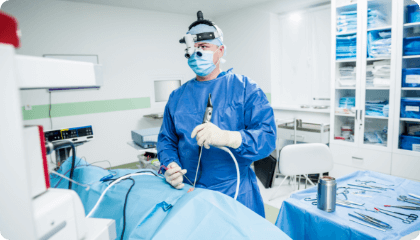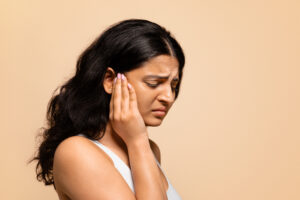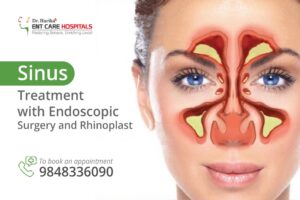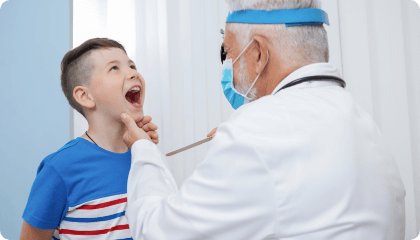About Nose
The nose is the primary organ for the sense of smell and serves as the prominent structure in
the respiratory system. It plays a key role in the entire process of respiration by providing air for
breathing, conditioning the air for better inhalation by filtering, warming, and moistening the air;
along with the self-cleaning process by extracting the foreign particles from the inhalations.
The nose problems can arise due to a variety of reasons which can include allergies, viral or
bacterial infections, abnormal growths like polyps, and abnormalities in the nasal structures that
can be either congenital (birth defects) or due to an injury, that blocks the airways and interferes
with breathing.
-

-
Here is a list of common nose problems which need expert care from ENT specialists and
surgeons for evaluation, diagnosis, prevention, and treatment.
Nasal Block: The nasal block is nothing but a stuffy nose. It is also referred to as nasal
congestion or nasal obstruction which interrupts the entire respiration process and
makes it difficult to breathe normally. A nasal block is often a symptom of upper
respiratory infections such as sinusitis or nasal septum deviation or due to polyps in the
nose. It can also be accompanied by other symptoms like runny nose and persistent
headache which makes you feel tired and interferes with daily activities. Usually, the
nasal block can be a result of a common cold or nasal allergy or deviated nasal septum,
or an increase in the size of the adenoid.
Nasal Allergy: A nasal allergy is an inflammatory reaction to certain allergens when they
come into contact with the airways and cause irritation. The nasal allergies are referred
to as Allergic Rhinitis in medical terms, which is of two types, namely, seasonal and
perennial. Seasonal allergies occur due to the response to seasonal changes during the
spring or rainy season. While perennial allergies can occur any time in the year in
response to dust, pollen, mold, and pet dander. The main symptoms of a nasal allergy
can include runny nose, sneezing, stuffy nose, red and watery eyes, itchiness in the
nose, ears, eyes, and throat, headache, etc. In the case of nasal allergies, the skin prick
test is the gold standard test to diagnose allergy and immunotherapy should be
considered for the cure.
Bleeding from the nose: Nosebleeds are common in children and adults. But frequent
nosebleeds can indicate a serious medical condition that requires expert medical
assistance. The treatment for nosebleeds depends on their cause. The nose contains a
complex network of many thin blood vessels, all over its internal surface. The most
common nosebleeds occur from the front of the nose, due to rupture or damage of blood
vessels when they come in contact with dry and hot air during breathing or due to
nose-picking in children. These types of nosebleeds occur usually in summers. While the
nosebleeds that occur at the back of the nose usually occur due to high blood pressure
commonly seen in adults
Sinusitis or Sinus infection: Sinusitis, often known as sinus infection is the
inflammation of the air cavities present in the skull and facial bones. The main cause of
sinusitis includes a virus, bacteria, or rarely fungus that may irritate the sinuses and
causes inflammation. The common symptoms of sinus infection seen in adults are
decreased sense of smell, fever, runny or stuffy nose, cough, headache, and fatigue. In
children, a sinus infection can be identified if they have any symptoms like a cold that
lasts more than a week with fever, swelling around the eyes, earaches, bad breath,
coughing. Usually, a sinus infection goes away within one to two weeks with proper
medication and care. But, recurrent sinus infections require surgical intervention to avoid
the risk of future infections and restore your quality of life.
Headache: Headache is often a common symptom of nasal problems, especially in case
of nasal block or congestion and nasal allergies. This is because of the inflammation of
the sinuses that are caused by an infection or allergy. Since the sinuses are present in
the skull and facial bones as well, the inflammation of sinuses from an infection can
cause pressure in the cheeks, forehead, and around the eyes. Also, an allergy causes
nasal congestion due to trapped mucus in the sinuses. So, the extra stress on sinuses in
the skull can lead to headaches which can be managed when their cause is addressed
and treated in the right way.
Snooring in adults: Snoring is a harsh sound that occurs when the airflow during sleep
is constricted due to narrowed airways. This makes the soft tissues present along the
airways to vibrate and causes snoring. Though snoring in adults is ignored thinking as it
is very common, it often indicates an underlying medical condition. It is the most
common symptom. of sleep disorder, known as sleep apnea. Apart from this, it is also
common in people who are overweight or obese, in whom the extra fat in the neck tissue
prevents air from flowing freely when they sleep. But, the main causes of snoring in
adults can be a result of nasal problems which include deviated nasal septum, abnormal
growths in the nose such as polyps, nasal congestion from infections or allergies, etc.
Snooring in children: Though snoring is not so common in children when compared to
adults, it may occur in some children. It is common when kids suffer from nasal
congestion because of cold or flu, but frequent or severe snoring is often a concern. The
most common reason for snoring in children is adenoid hypertrophy that has to be
addressed at an early age to prevent serious ailments in the future such as breathing
difficulties, hearing loss, frequent ear infections, etc. Snoring in children affects their
quality of sleep which leads to behavioral issues in the daytime. Some of the signs of
snoring in children include increased irritability, crankiness or being aggressive,
excessive sleeping during the day, difficulty waking up in the morning, bed wetting in
older kids, and struggling to pay attention due to lack of quality sleep at night.
Loss of sense of smell: Also known as anosmia, is the condition in which people
experience loss of the sense of smell partially or completely. This loss can be either
temporary or permanent which can be determined by the cause of the condition.
Temporary anosmia can be due to the irritation of the lining in the nose, which usually
happens in the case of cold or allergies. In such cases, the sense of smell will be
restored on its own once the allergy or the cold gets treated. But, there are some serious
conditions that can cause permanent anosmia due to brain or nerve damage, such as
brain tumors or head trauma from severe injuries.
Runny nose or nasal discharge: A runny nose is nothing but the discharge or dripping
of mucus from the nostrils. It is caused when the nasal tissues get irritated. Though the
runny nose isn’t a serious condition and very common, it increases irritability and can be
annoying, especially in children. There are many causes which can irritate the nasal
tissues and results in the runny nose which include, cold, allergies, sinusitis, flu, nasal
septum deviation, nasal polyps, allergic reactions to some medications, overuse of nasal
spray, etc
Foreign body in the nose:This is most common in children and a common complaint in
emergency cases. It can also occur in adults with mental disabilities. A foreign body in
the nose means the presence of an object in the nose which is often dangerous and can
cause serious injuries and infections. Though parents are very attentive, it is a common
habit of kids to place objects in their mouths, nose and ears while playing. This can lead
to choking hazards and can be very serious if not addressed by the medical experts in
time. The most common foreign objects which are usually found in children are small
toys, pieces of eraser, tissue, dirt, tiny plastic or metal objects, food particles, etc. When
any of the foreign objects are stuck in the nose, adults or kids will experience
foul-smelling nasal drainage and difficulty in breathing.
 Types of treatment:
Types of treatment:
 Advantages being:
Advantages being:












